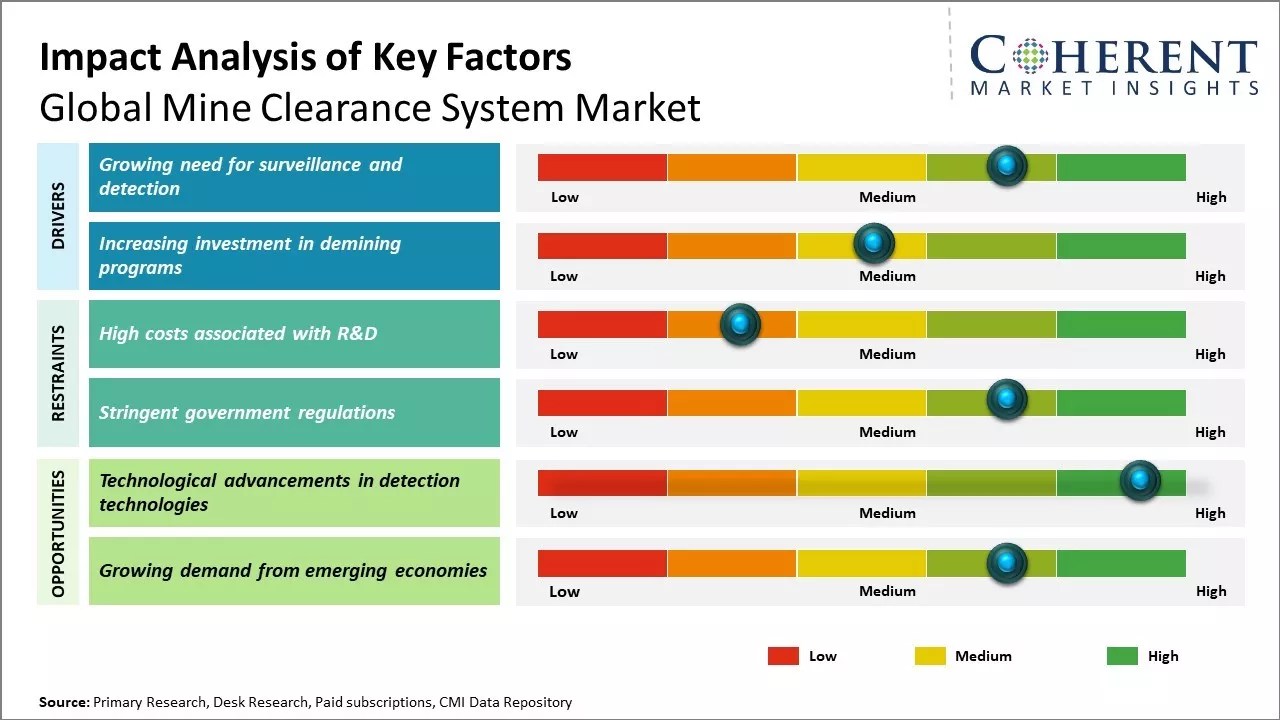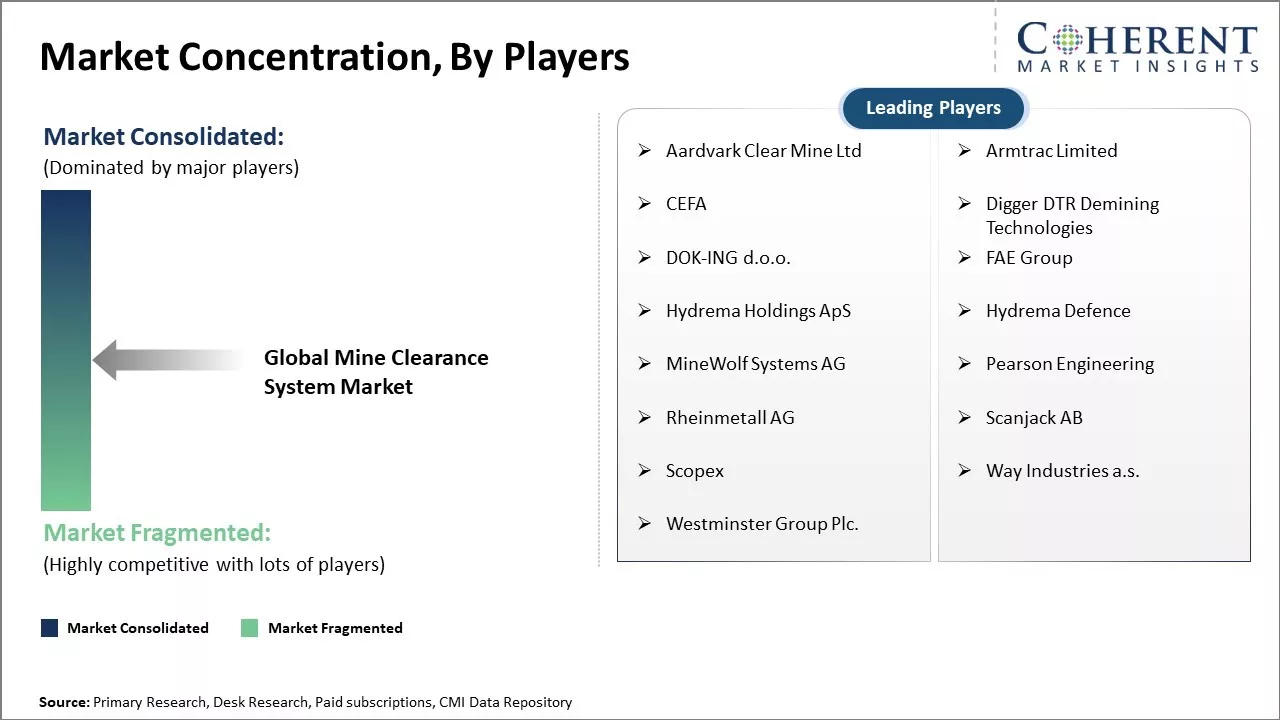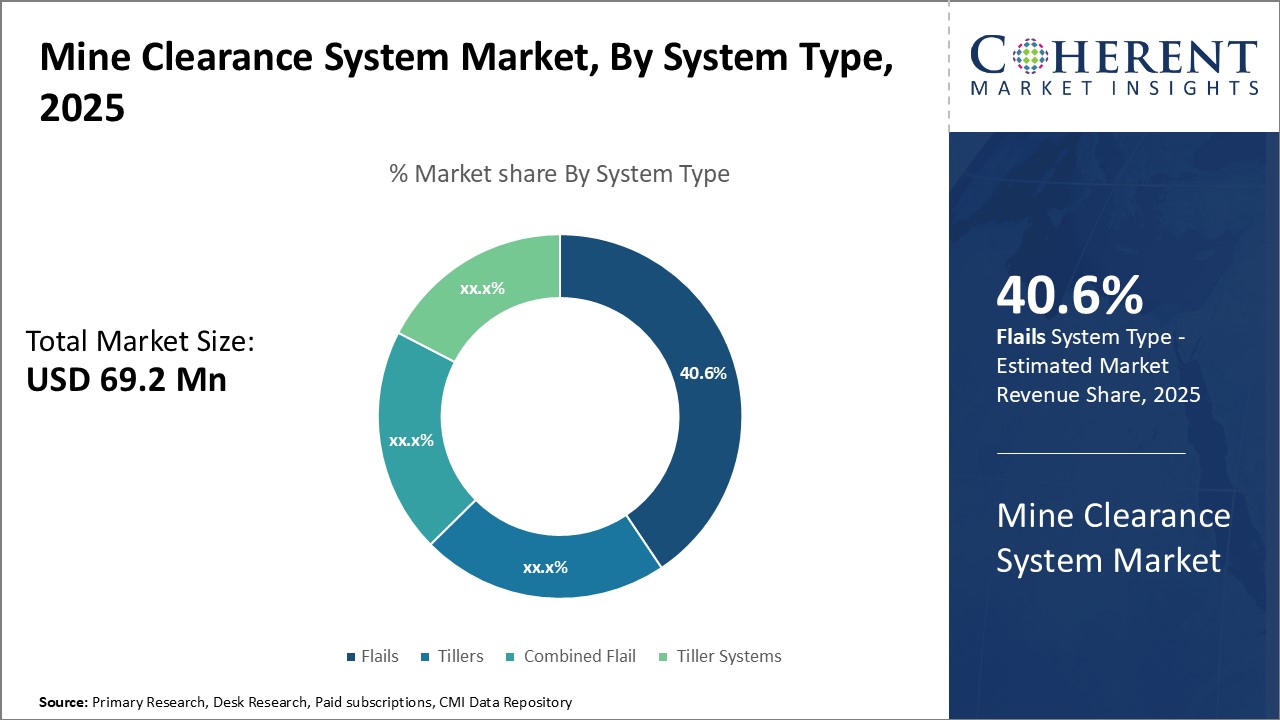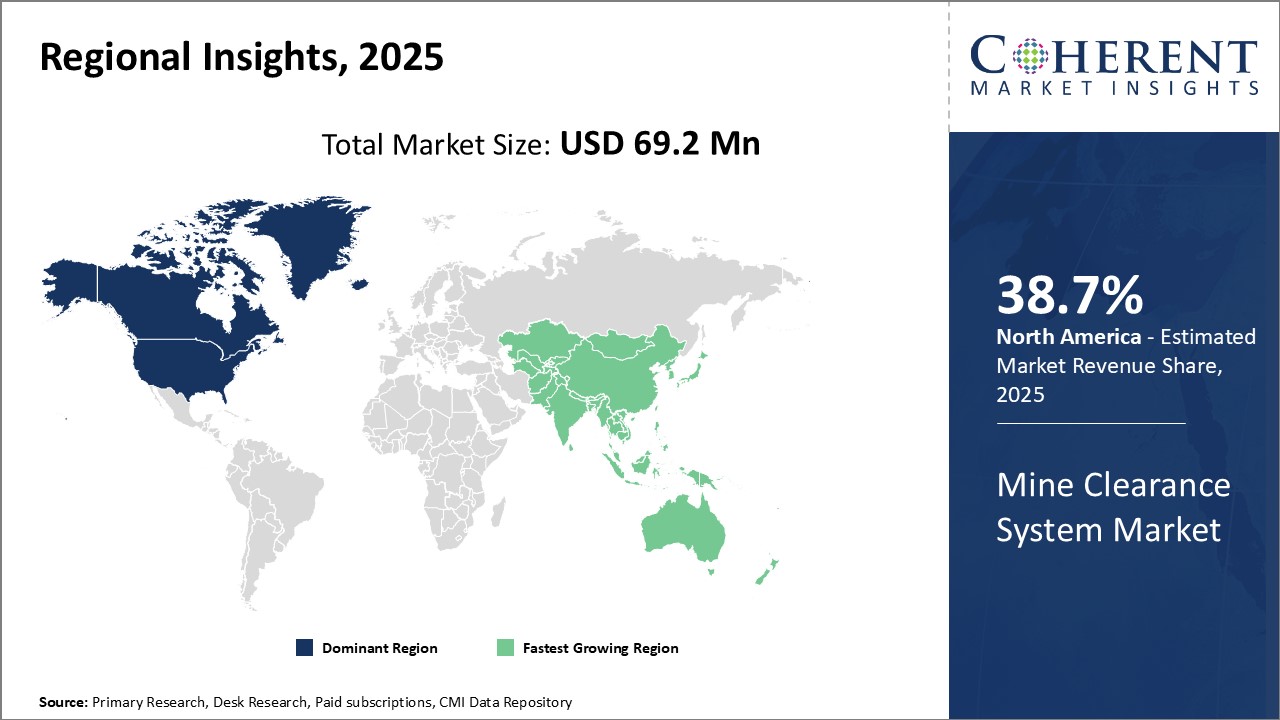The global mine clearance system market is estimated to be valued at US$ 69.2 Mn in 2025 and is expected to reach US$ 98.8 Mn by 2032, exhibiting a compound annual growth rate (CAGR) of 5% from 2025 to 2032.

Discover market dynamics shaping the industry: Download Free Sample
The mine clearance system market is expected to witness steady growth over the forecast period. Increased investment in the research and development of improved technologies will create new growth opportunities for players operating in this market. Several mines laid during previous conflicts still remain unexploded posing risk to the public. Adoption of robots and drones integrated with sensors, cameras, and other hi-tech equipment for seamless detection and disposal of landmines and IEDs ensures safety of humans. Key players are also focusing on making systems affordable which can increase their adoption rate in low- and middle-income countries. However, high initial investment and challenges associated with operating in hazardous environments can restrain the market growth during the forecast period.
Growing need for surveillance and detection
As conflicts around the world continue to spread explosive remnants of war such as landmines, the need for effective and reliable mine clearance systems has become more crucial than ever. Over vast swathes of land lie deadly explosives that were laid decades ago, continuing to maim and kill civilians long after hostilities have ended. The scale of contamination is truly staggering, an enduring tragedy that echoes down the generations. Conventional clearance methods are labor intensive, costly and place human lives at risk every day.
While humanitarian demining organizations have removed millions of landmines and explosives over the past decades through extensive non-technical and technical survey methods, the remaining challenge is immense. New forms of technical solutions are being sought to address this pressing global problem in a more efficient manner. Technologies incorporating advanced sensors, unmanned vehicles, and data analytics show promise in enabling faster, safer, and more precision-based detection and clearance operations compared to traditional manual methods. The ability to accurately map and characterize mined areas from a distance without putting people in harm's way is becoming an increasing priority for militaries and civil societies alike.

Get actionable strategies to beat competition: Download Free Sample
Increasing investment in demining programs
There is a growing global focus on investing in mine clearing initiatives to curb the risks posed by explosive remnants in post-conflict areas. Several nations and donor agencies have ramped up funding for demining programs aimed at making contaminated lands safe for communities. For instance, countries like Cambodia and Croatia that were earlier weighed down by massive mine contamination have now achieved a 'mine-free' status after sustained clearance drives backed by international aid organizations. Encouraged by their success, many developing countries now attach greater priority to allocating national budgets for mine action planning and surveys and procurement of essential equipment.
Key Takeaways from Analyst:
Some key drivers of this market include ongoing conflicts and threat of landmines in several regions and growth in demining activities to enable the rebuilding of infrastructure. Rising funding for humanitarian demining from international organizations will also support the demand for mine clearance equipment.
However, high costs associated with advanced mine detection and clearance technologies could restrain market expansion to some extent. Established players face competition from local manufacturers offering cheaper alternatives in price-sensitive developing markets as well. Meanwhile, stringent regulations over explosives and weapons may impact technology innovation and upgrading.
The North America region currently dominates global sales. Ongoing border disputes and reliance on landmines for security also sustains growth here. Demining activities are likewise gaining traction across major battle-scarred territories in Africa and the Middle East.
Within equipment categories, demand is the highest for metal detectors and ground penetrating radars used in prior surveys and clearance of mined areas. However, robotic systems and unmanned vehicles offering stand-off detection promise to be the fastest growing segment with improvements in autonomous technology. New solutions combining hyperspectral imaging, AI and advanced sensors also allow for quicker, safer scanning of large mined sites.
Market Challenges: High costs associated with R&D
The high costs associated with research and development is significantly restraining the growth of the global mine clearance system market. Developing advanced technologies for detecting and clearing landmines requires extensive research and testing over several years. This R&D process involves experimenting with different sensor technologies, robotic platforms, data algorithms, and processing techniques to identify buried explosives with high accuracy levels. These technical development requires sizable investments in labor hours, material procurement, and field trials.
Market Opportunities: Technological advancements in detection technologies
Technological advancements in detection technologies present a great opportunity in the global mine clearance system market. The use of advanced technologies like robotics, drones, AI, and ground penetrating radars have allowed demining operations to become faster, more efficient, and safer compared to traditional manual methods. These new detection technologies are enhancing the capabilities of demining teams tremendously.

Discover high revenue pocket segments and roadmap to it: Download Free Sample
Insights By System Type - Flails Drive Growth in the Global Mine Clearance System Market By System Type Segment
The flails segment is expected to account for 40.6% share of the global mine clearance system market in 2025 classified by system type. Flails are highly effective at clearing landmines and explosive remnants of war due to their powerful beating or hammering action. Flails use a rapidly rotating chain or line of heavy steel hammers or balls attached to a horizontal shaft. As the flail drum rotates at high speeds, the hammers or balls beat the ground with powerful impact forces. This flailing action is highly effective at detonating buried landmines and unexploded ordnance.
The hammering impacts generated by flails can penetrate deeper into the soil compared to other system types like tillers. This allows flails to effectively detect and destroy landmines buried at greater depths underground. Flails can clear a wide area at once due to their mechanics of using multiple rotating hammers. They do not require very precise or careful movements like manual detection systems, allowing for faster clearance rates over large plots of contaminated land. Flails are also better suited for handling varied terrains including rocky soils compared to tillers, providing more flexibility in deployment.
Advancements in flail technology have further increased their popularity. Updated digitally-controlled flail systems offer higher power, variable speed settings, and remote control for improved safety. Flails are now mounted on larger remote-controlled vehicles with cameras for real-time monitoring from a distance. Such innovations have made flails even more effective at clearing mines while reducing risks to human life. Their demonstrable performance, versatility, and ongoing improvements contribute to flails having the highest demand in the global mine clearance system market.
Insights By Mode Of Operation - Remote Control Operation Drives Growth in the Global Mine Clearance System Market By Mode of Operation Segment
Within the global mine clearance system market segmented by mode of operation, the remote-control operation segment is expected to hold 59% of the market share in 2025. This is because remote-controlled systems allow mine clearance activities to be performed from a safe distance without putting humans in harm's way. Traditional manual mine detection and disposal requires deminers to physically locate and detonate mines on-site, exposing them to grave risks from accidental explosions.
Remote-controlled mine detection and clearance vehicles allow surveying, prodding, and detonation of mines from an off-site control room using cameras, screens and joysticks. This significantly reduces the risk of human casualties from landmine accidents. It also allows multiple vehicles and larger areas to be cleared simultaneously compared to manual operations. Remote systems provide better monitoring and precision than older manual methods thanks to technologies like ground-penetrating radar, metal detectors, and CCTV.
The convenience, safety benefits and performance advantages of remote-control operations have made them increasingly standard for demining projects. National mine action centers and international non-profit organizations prefer deploying remote technologies to address the global landmine issue in a faster, more efficient, and cost-effective manner while fully protecting human lives. Ongoing AI and robotics research is further enhancing the autonomy and capabilities of remote mine detection and disposal systems. This will likely sustain remote control's dominance in the global mine clearance system market segmented by mode of operation.

Need a Different Region or Segment? Download Free Sample
North America has established itself as the dominant region in the mine clearance system market. The region is expected to account for 38.7% of the market share in 2025. The large defense budgets and well-established defense infrastructure in countries such as the U.S. and Canada have enabled significant investments in the research and development of new mine countermeasure technologies. Several leading players operating globally have set up their headquarters and manufacturing bases in the region in order to cater to the sizeable local demand. Moreover, North American countries have also been spearheading global humanitarian mine action and regularly conducting demining operations abroad, which drives additional requirements for modern equipment.
The Asia Pacific region has emerged as the fastest growing regional market for mine clearance systems in recent times. Countries like China, India, and Pakistan continue to witness rising security threats owing to their geopolitical complexities and volatile ties with neighbors. This has led their defense organizations to progressively invest in bolstering capabilities for tackling landmines and improvised explosive devices. The Asia Pacific region is also gaining from the expanding industrial and construction activities across developing nations, which increases the needs for clearing ordnance remnants from former battlefields and training ranges to enable infrastructure projects. Local system integrators in the region have enhanced their engineering and fabrication skills to contribute to the domestic demand as many countries focus on promoting indigenous defense production.
In Europe, significant demand comes from NATO- North Atlantic Treaty Organization allied countries that have actively supported peacekeeping and stabilization efforts in conflict zones across Africa and the Middle East, thereby using specialized vehicles and drones. Countries like Germany, France, and the U.K. also export solutions to developing nations and impact the cross-border trade flows. On the other hand, ongoing border disputes and terrorism continue to influence the Russian and Eastern European defense purchase decisions toward mine-detecting gear. While price points are higher compared to Asian suppliers, European OEMs have strong brand recognition and an image of high-quality offerings to hold sway in global procurements.
Mine Clearance System Market Report Coverage
| Report Coverage | Details | ||
|---|---|---|---|
| Base Year: | 2024 | Market Size in 2025: | USD 69.2 Mn |
| Historical Data for: | 2020 To 2024 | Forecast Period: | 2025 To 2032 |
| Forecast Period 2025 to 2032 CAGR: | 5.2% | 2032 Value Projection: | USD 98.8 Mn |
| Geographies covered: |
|
||
| Segments covered: |
|
||
| Companies covered: |
Aardvark Clear Mine Ltd, Armtrac Limited, CEFA, Digger DTR Demining Technologies, DOK-ING d.o.o., FAE Group, Hydrema Holdings ApS, Hydrema Defence, MineWolf Systems AG, Pearson Engineering, Rheinmetall AG, Scanjack AB, Scopex, Way Industries a.s., and Westminster Group Plc. |
||
| Growth Drivers: |
|
||
| Restraints & Challenges: |
|
||
Uncover macros and micros vetted on 75+ parameters: Get instant access to report
*Definition: The global mine clearance system market includes equipment and solutions used for clearing and detecting landmines and other explosive devices that are generally leftover from war zones. Major products in this market include mine detection systems, mine protection equipment, mine clearing tools and vehicles, personal protective equipment, and training simulators. The market aims to provide essential technologies and services to militaries and humanitarian organizations working towards ridding the world of dangerous landmines and making affected regions safe for human use again.
Share
Share
About Author
Suraj Bhanudas Jagtap is a seasoned Senior Management Consultant with over 7 years of experience. He has served Fortune 500 companies and startups, helping clients with cross broader expansion and market entry access strategies. He has played significant role in offering strategic viewpoints and actionable insights for various client’s projects including demand analysis, and competitive analysis, identifying right channel partner among others.
Missing comfort of reading report in your local language? Find your preferred language :
Transform your Strategy with Exclusive Trending Reports :
Frequently Asked Questions
Joining thousands of companies around the world committed to making the Excellent Business Solutions.
View All Our Clients